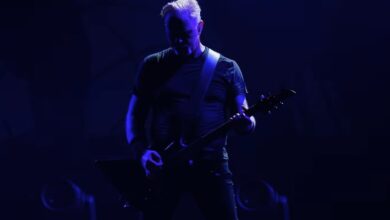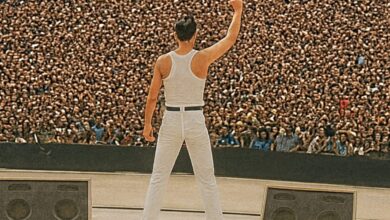Royal Marines Reimagine Pink Floyd’s Iconic Anthem into a Breathtaking Masterpiece at Royal Albert Hall
The first sign that “Another Brick in the Wall” would evolve into something extraordinary came the moment Royal Albert Hall dimmed into deep indigo and the Corps of Drums marched into flawless formation. This wasn’t a routine tribute—it was the Massed Bands of His Majesty’s Royal Marines transforming Pink Floyd’s rebellious anthem into a symphonic statement of precision and power. A crisp snare cadence demanded attention; low brass stirred with military poise; and the melody climbed through the dome like a beacon of defiance reborn. Faces lit, phones rose, and disbelief turned to exhilaration as art met discipline.
What instantly made the performance riveting was its vision. Instead of replicating the original track’s sleek, rhythmic drive, the Marines reshaped it into a ceremonial drama—half parade, half rock opera. The bass pulsed with the steadiness of a marching regiment, trumpets drew sharp silver lines through the melody, and woodwinds laced soft transitions that allowed the chorus to arrive not as rebellion but as revelation. The irony was magnetic: a song born from defiance now reborn within an ensemble built on order, and yet both sides found their voice in perfect harmony.
From the opening bars, the Corps of Drums commanded the narrative. Each rudiment spoke like punctuation; the rolls shimmered across the ceiling; and every rhythmic strike landed at the Hall’s perfect resonance point. The snares turned rock’s heartbeat into a ceremonial cadence without draining its pulse. When their rhythm expanded into a glimmering canvas for the brass, the energy lifted from the floor like an aircraft taking flight. The Royal Albert Hall’s vast acoustic dome transformed each note into thunder, reverberating with both order and passion.
Then came the flood of tone and texture. Muffled cornets infused the verses with quiet rebellion; trombones bounced the groove with subtle swing; and flutes danced through the syncopations like sparks on metal. Instead of electronic layers, an orchestra of tone color replaced technology: mellow horns bringing depth, piercing trumpets bringing heat, and euphoniums smoothing the edges. The melody, freshly uniformed, didn’t sneak in—it marched proudly, each section saluting in turn as the crowd erupted in a mix of recognition and awe at how something so familiar could sound so new.
Lighting transformed sound into story. The show began in harsh white tones—a nod to the cold classroom the original lyrics condemned—then exploded into deep blues and purples as the chorus soared. Cameras followed every motion with cinematic grace: close-ups on the drummers’ synchronized sticks, sweeping aerials of shining brass formations, and wide angles capturing the sound rippling through ranks like wind through banners. The audio mix honored both power and precision, balancing the anthem’s groove with intricate counterpoint. It was rock reimagined as theater—alive, vibrant, and proud.
Audiences at the Mountbatten Festival of Music expect reinvention, and this night delivered it in style. The Royal Marines’ annual residency is legendary for its bold programming—blending tradition with surprise. The inclusion of Pink Floyd’s defiant anthem was more than a novelty; it was a declaration that rebellion and structure can coexist. Within those stone walls, patriotism met psychedelia, and somehow they embraced. The crowd, filled with veterans, music lovers, and first-timers, experienced not contradiction but conversation—a disciplined army of musicians celebrating creative freedom.
The arrangement itself was architectural brilliance. The bass line marched with confident symmetry; percussion defined space with crisp punctuation; and when the chorus erupted—“We don’t need no education”—it did so as a wave of brass harmonies rising layer by layer toward the rafters. The lyrics once condemned conformity, but here they celebrated expression within structure. That paradox ignited the atmosphere, turning rebellion into triumph. The wall was not shattered but reshaped—standing tall, now symbolizing unity instead of division, framed by glinting instruments and faultless timing.
The real thrill came from hearing how gracefully the tune adapted to this new identity. What began as a protest groove evolved into a majestic march, its tension transformed into grandeur. The guitars of the original became a chorus of horns and trumpets, each one radiating power and purpose. When the melody reached its long, sustained notes, the brass held not only tone but emotion—filling every corner of the Hall until the audience couldn’t help but hum along. The divide between rockers and traditionalists dissolved under one unifying rhythm.
Timing was everything. The Marines built anticipation with patience, adding layers in each repetition—richer brass, brighter percussion, and fuller harmony. The second verse shimmered with new color; the bridge arrived like sunlight after storm. Every accent, every breath felt choreographed by instinct rather than plan. The audience became part of the rhythm, leaning forward in sync with the drumline’s every flick and roll. Without choreography or words, a conversation unfolded between performer and listener—a dialogue written entirely in rhythm and resonance.
The online recording has since immortalized the moment for audiences worldwide. Every replay allows discovery: the quick silver run of clarinets in the second verse, the synchronized shimmer of cymbals timed perfectly to the lights, the triumphant brass crest in the final chorus. It’s a rare concert where the camera captures both grandeur and intimacy, where precision feels human. For anyone watching remotely, it delivers not just sound but sensation—the thrill of sitting front-row in one of the world’s most storied halls.
This wasn’t the Marines’ first dance with rock history. Their catalog already includes symphonic takes on Queen, Led Zeppelin, and even pop giants—each arranged with intelligence and flair. But “Another Brick in the Wall” stands apart as both homage and reinvention. Featured in the Mountbatten Festival of Music 2017, it became a fixture in their modern repertoire, a staple that bridges concert hall formality with cultural nostalgia. It’s not parody but partnership—where rock meets regiment in an equal exchange of respect and rhythm.
Listen closely and small treasures appear: a triangle echoing a school bell, snare flourishes disguised as whispers, and sly rhythmic syncopations teasing the crowd between beats. These details make the arrangement shine. Rather than mocking Pink Floyd’s legacy, the Marines conversed with it—adding wit where others might add weight. Audiences left humming the melody but talking about the subtleties, the clever turns that elevated the performance from mere novelty to masterful craft. It wasn’t imitation; it was dialogue through sound.
As the final refrain climbed, the lights shifted from icy whites to golden warmth, and the music swelled into a glorious crescendo. Trumpets gleamed, horns softened the edges, and trombones anchored the finale with noble gravity. The last chord hung like a halo beneath the Hall’s dome, and the crowd responded as one—a surge of applause and laughter mixed with awe. The Marines bowed, grinning, knowing they had done the impossible: turning rebellion into reverence without losing either soul.
Beneath the spectacle, the symbolism resonated deeply. To take a song about defying control and present it through a disciplined, uniformed ensemble is to prove that music transcends contradiction. Order can carry passion; tradition can express freedom. The Marines didn’t tame Pink Floyd—they translated them, showing that precision can amplify emotion rather than suppress it. It was a performance that embodied unity, artistry, and the simple truth that expression doesn’t need rebellion to feel alive.
As the festival continued with film themes and orchestral showcases, the echoes of that performance lingered like an encore nobody wanted to end. Attendees left quoting the hook, replaying phone clips, and debating which section—brass or percussion—stole the night. The Marines had achieved what few could: they made an audience think, laugh, and cheer in equal measure. And for every skeptic who doubted that military precision could breathe new life into rock rebellion, there was now undeniable proof.
Years later, the performance endures online, collecting millions of views and reactions from across the globe. Musicians study its precision; casual viewers return for its sheer spectacle. What began as a creative experiment has become a cultural benchmark—a reminder that great music knows no walls, only bridges. In the end, the Marines didn’t just cover Pink Floyd. They conversed with them across generations, turning “Another Brick in the Wall” into a living monument to imagination, discipline, and the enduring pulse of rock’s defiant heart.





